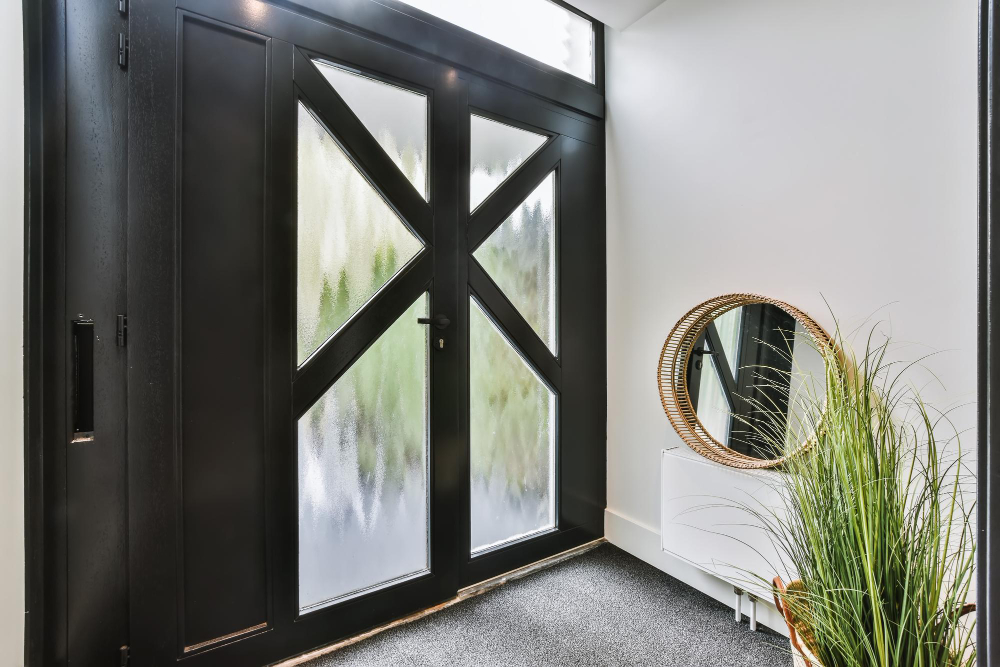
The entry door of every house speaks volumes to the personality within, sets expectations, and either welcomes visitors warmly or leaves them feeling indifferent. In recent years, plain, solid doors have been abandoned in favour of a more dramatic alternative: entry door designs with glass panels.
The transition to glass is not only a matter of trends. There is something inherently attractive about doors that manage to fuse functionality with aesthetics to make entranceways that are as welcoming as they are safe.
The Appeal of Glass in Entry Doors
Entry doors with glass panels address various issues that people frequently encounter. Monotonous dark doors and doorways are opened up and brightened with natural illumination filtering through glass cutouts. Cramped corridors also seem wider because of the openness of the glass.
In addition to functionality, these doors are extremely flexible. A sleek glass panel door can make a contemporary home feel more sophisticated, while divided glass panels add character to traditional architecture. The material works across styles because it adapts rather than dominates.
Property values also benefit from this upgrade. Real estate professionals often note how modern entry door designs with glass create immediate positive impressions during showings. The investment typically pays off when it comes time to sell.
Trending Glass Door Styles Worth Considering
- Full Glass Panel Doors
This features dramatic panels with large areas of glass, which, in many cases, are almost as tall as the door itself. Safety is guaranteed by tempered or laminated glass, and privacy variations can be achieved by using frosting or etching. They fit quite appropriately in minimalist or even industrial-type homes where sleek lines are the priority.
- Vertical Glass Strips
Rather than dominating the door, these narrow glass panels create subtle visual interest. Positioned strategically, often near the handle area, they maintain privacy while adding light and style. The approach works well when homeowners want the benefits of glass without feeling too exposed.
- Multi-Panel Grid Designs
These doors feature several smaller glass panes separated by frames, creating patterns that feel both modern and timeless. The divided approach offers flexibility with glass opacity choices while maintaining structural strength. Bronze or black frames add a contemporary edge to this classic concept.
- Extended Glass Features
Some homeowners go beyond the door itself, incorporating glass transoms above or sidelights flanking the entrance. This creates grand, hotel-like entries that make even modest homes feel more impressive. The approach works best with larger doors that can handle the visual weight.
- Pivot Door Designs
Instead of traditional side hinges, pivot doors rotate on points at the top and bottom, creating dramatic opening experiences. When combined with glass panels, they serve as functional art pieces. These doors suit contemporary homes where making statements matters.
Addressing Security Concerns
Homeowners naturally wonder about safety when considering glass entry door designs. Modern manufacturing has largely solved these concerns through engineering advances.
Today’s entry door glass uses laminated or tempered materials that resist breaking and, when damaged, break safely. There has also been a stunning augmentation of energy efficiency. The low-E coating, as well as double glazing, makes homes comfortable and safeguards interior furnishings against UV damage. Innovative glass doors are capable of withstanding severe winters without excessive energy expenses.
Making Smart Selection Decisions
Choosing the right glass door involves balancing several factors. Home architecture should guide style choices: minimalist homes suit clean glass panels, while traditional architecture often benefits from divided patterns.
Privacy needs vary by location and personal preference. Frosted, textured, or tinted glass provides light transmission without transparency. Strategic placement of glass panels can maximize benefits while maintaining comfort levels.
Energy performance matters in most climates. Thermal break frames and high-performance glazing systems keep operating costs reasonable while providing year-round comfort. Quality materials like aluminum or fibreglass ensure longevity with minimal maintenance requirements.
Professional Installation Matters
Glass entry doors should be installed accurately in order to work satisfactorily. Correct hardware adjustment, alignment, and sealing have implications for energy efficiency and security. Employing qualified installers will ensure that the doors are constructed as per the local building codes and will work properly.
Modern entry door systems with European-inspired designs and sophisticated glazing technology are the specialty of businesses like Window Star. Our lifetime guarantees and thermal break aluminum frames offer both visual appeal and comfort of mind.
Better performance and long lifespan are typically the outcomes of professional installation, which compensates for your investment. Under proper installation, quality doors can serve for decades more and have low maintenance requirements as compared to their low-cost alternatives.
Read more: How to Choose the Perfect Front Door for Your Home
Frequently Asked Questions
- Are glass entry doors secure enough for front door use?
Modern laminated glass and multi-point locks provide excellent security comparable to solid doors. - Do glass doors increase heating and cooling costs significantly?
High-performance glazing and thermal frames minimize energy impact when properly selected and installed. - Can glass entry doors withstand harsh winter weather conditions?
Quality doors with proper sealing and thermal breaks perform well in extreme climates. - Which types of glass can offer privacy with maximized natural light?
Textured, frosted, or tinted glass allows light to pass through while positively preserving your privacy. - What is the life expectancy of modern glass entry doors?
High-quality doors made with high-quality materials may last up to 20 to 30 years without the need for much maintenance.

